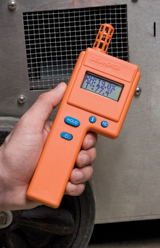 Here on the Delmhorst blog, we frequently talk about the benefits of moisture meters, those devices that can take a moisture content reading in different building materials.
Here on the Delmhorst blog, we frequently talk about the benefits of moisture meters, those devices that can take a moisture content reading in different building materials.
While immensely useful for testing building materials, you often need a reading of the environmental conditions as well. For this task, you need a thermo-hygrometer.
Although many are familiar with moisture meters for home inspectors, contractors, and the like, many people don’t know as much about thermo-hygrometers.
To help you gain a better understanding of the usefulness of a thermo-hygrometer, here are a few answers to some frequently-asked thermo-hygrometer questions:
1: What Makes Thermo-Hygrometers Different from Moisture Meters?
Thermo-hygrometers are very different from both pin and pinless moisture meters.
Whereas pin and pinless moisture meters are designed to take a %MC reading of the moisture in a specific building material, thermo-hygrometers measure the temperature and relative humidity (RH) in the air for a given area.
2: What Are Some of the Common Issues with Thermo-Hygrometers?
There are a few challenges to overcome when using thermo-hygrometers, just like there would be with any other piece of testing equipment. Common issues include:
-
Accounting for Temperature. When taking an RH reading for a given area in a structure, the ambient temperature can affect the accuracy of the reading. The higher the humidity, the more the temperature will affect the reading. For example, if the RH in a room is 80% at 33 °C, (91.4 °C), the a change of 1 °C (1.8 °F) would alter the RH reading by as much as four percent.
-
Sensor Tolerance. Every thermo-hygrometer has a built-in margin of error, or “sensor tolerance.” This means that, for any given reading, there may be a difference between the reading given and the actual RH of the area. For example, if the sensor tolerance value of a hygrometer is 3%, and the RH of a room is 33%, then the device may return a sensor reading between 30% and 36%.
-
Care and Maintenance. RH sensor materials will degrade over time as they are exposed to contaminants in the air. This will eventually cause the thermo-hygrometer to lose accuracy over time. This sensor drift can compromise reading results, which means the sensor material will eventually have to be replaced.
Despite these issues, thermo-hygrometers are still invaluable tools for building inspectors, flooring contractors, and restoration specialists.
3: Why Would I Need a Thermo-Hygrometer?
Considering that thermo-hygrometers don’t allow for a specific reading of %MC like moisture meter readings would, why would you need one of these devices?
Common uses for thermo-hygrometers include:
-
Moisture Intrusion Detection. Since thermo-hygrometers get a reading of the relative humidity in the air over a large area, such as in a room of a building, they are useful for detecting signs of moisture intrusion. If a room has an abnormally high RH, there is a good chance there are building materials in the room that have been moisture-compromised. This allows you to narrow your search for a moisture intrusion source to the room(s) with a high RH.
-
Checking RH for Acclimating Wood. When acclimating flooring or structural lumber for use in a building, it’s important to make sure that the wood is properly acclimated. Since wood is a hygroscopic material, it will absorb or bleed moisture until it reaches equilibrium with the surrounding air. Knowing the RH of the air in a structure gives you a better idea of how close a sample of wood is to reaching equilibrium moisture content (EMC).
-
Checking Concrete Slabs. Contractors working with concrete use thermo-hygrometers with in-situ probes to check the moisture conditions deep in the slab. This is critical to following the ASTM F-2170-11 standard, and lets contractors know when a slab is ready to be built on.
Properly cared for and maintained, thermo-hygrometers are incredibly useful tools for any specialist who has to account for ambient moisture conditions on the job.
Comments